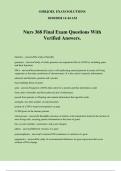©SIRJOEL EXAM SOLUTIONS
10/10/2024 11:44 AM
Nurs 368 Final Exam Questions With
Verified Answers.
Genetics - answer✔the study of heredity
genomics - answer✔study of whole genomes (an organisms full set of DNA), including genes
and their functions
DNA - answer✔deoxyribonucleic acid, a self-replicating material present in nearly all living
organisms as the main constituent of chromosomes. It is the carrier of genetic information.
adenosin and thymine; guanine and cytosine
basic building block of genes
gene - answer✔sequence of DNA that codes for a protein and thus determines a trait
basic units of heredity and basic physical unit of inheritance
passed from parents to offspring and contain information that specifies traits
arranged, one after another, on chromosomes
portion of a DNA strand corresponds to a gene
21,000 genes in the human genome
chromosome - answer✔a threadlike structure of nucleic acids and protein found in the nucleus of
most living cells, carrying genetic information in the form of genes.
has a p arm (smaller), centromere, and q arm (longer)
alleles - answer✔different versions of a gene
polymorphisms - answer✔a common DNA mutation or variation of a gene
epigenetics - answer✔the study of environmental influences on gene expression that occur
without a DNA change
, ©SIRJOEL EXAM SOLUTIONS
10/10/2024 11:44 AM
study of heiritable changes in gene expression or phenotype caused by mechanisms other than
changes in the DNA sequence
mechanisms- affected by factors and processes (development, environmental chemicals,
drugs/pharmaceuticals, aging, diet)
health endpoints- cancer, autoimmune disease, mental disorders, diabetes
telomere - answer✔repetitive DNA at the end of a eukaryotic chromosome
protects end of chromosomes
high stress and illness cause shorter telomeres, decrease with aging
mutation - answer✔a random error in gene replication that leads to a change
phenotype - answer✔physical characteristics of an organism
genotype - answer✔genetic makeup of an organism
congenital - answer✔present at birth
gamete - answer✔specialized cell involved in sexual reproduction
chromosomes are singular, then pair up to form alleles (one from mother and one from father),
either dominant or recessive
somatic - answer✔pertaining to the body
haploid - answer✔an organism or cell having only one complete set of chromosomes
diploid - answer✔containing two complete sets of chromosomes, one from each parent.
autosome chromosome - answer✔chromosome that is not a sex chromosome
humans have 22 pairs of autosome chromosomes (44 total chromosomes)
sex chromosome - answer✔one of the pair of chromosomes that determine the sex of an
individual
xx or xy chromosomes (make up a total of 46 chromosomes
homozygous - answer✔having two identical alleles for a trait
dominant- AA, recessive- aa
heterozygous - answer✔having two different alleles for a trait
, ©SIRJOEL EXAM SOLUTIONS
10/10/2024 11:44 AM
Aa
autosomal dominant trait - answer✔phenotype seen if at least 1 of the alleles in the genotype
codes for that phenotype (Ex AA or Aa)
usually affected offspring have 1 or both parents affected
mating of 1 affected with an unaffected person results in 50% affected offspring
two affected parents can have unaffected children
males and females equally affected
examples of autosomal dominant traits - answer✔familial hypercholesterolemia (1 in 500)
polycystic kidney disease (1 in 500-1000)- adulthood, increase in BP, back pain, blood in urine,
UTIs, kidney stones, heart valve abnormalities, aneurysms
neurofibromatosis type 1 (1 in 3500)- cafe alait spots on newborns, neurofibromas, benign
marfan syndrome (1 in 5000)- connective tissue problems, heart, blood vessels, joint problems
achondroplasia (dwarfism) (1 in 15000 to 40000)
huntington's disease (1 in 20000)- may not know they have it until after childbearing years,
mental/physical deterioration
autosomal recessive trait - answer✔phenotype seen only if both alleles in the genotype code for
that phenotype (Ex- aa)
the traits of the recessive gene are present when both alleles (genes) in a pair are recessive
a person who has only one recessive allele for a disorder is considered a carrier
carriers do not show signs of the disorder
tay sachs disease - answer✔autosomal recessive disorder
ashkenazi jews, 1 in 3600 AJ people, 1 in 360,000 non-AJ
patient dies by 2-4, motor development, loss of all voluntary movement
visual deterioration, seizures, no cure
cystic fibrosis - answer✔autosomal recessive disorder
more common in whites
, ©SIRJOEL EXAM SOLUTIONS
10/10/2024 11:44 AM
1 in 2500-3500 children
frequency of carriers is 1 in 22
damage to lungs, sticky thick mucous
damage to organs
other autosomal recessive disorders - answer✔albanism- complete lack of melanin
phenylketonuria (PKU)- newborn screen, increased level of fetal alinine, intellectual disability
galactosemia- body processes galactose, leads to failure to thrive, liver failure, jaundice
sickle cell anemia
beta thalassemia
congenital adrenal hyperplasia
familial mediterranean fever
sex-linked traits - answer✔traits that are inherited with sex chromosomes
males affected much more often than females
daughters of affected males are carriers and will produce 50% affected sons
mothers of affected sons will sometimes have other affected males in her family
examples of sex linked traits - answer✔hemophilia (factor VIII)
duchenne muscular dystrophy- most severe, muscle wasting, cardiomyopathy, only live to 20s
color blindness
single gene inheritance disorders - answer✔DNA changes in one particular gene
categorized as dominant, recessive, or x linked
multifactorial disorders - answer✔conditions caused by interactions among one or more genes
and the environment
present and detectable at birth, isolated defects
nature vs nurture? both
also called 'complex' inheritance/disorders




